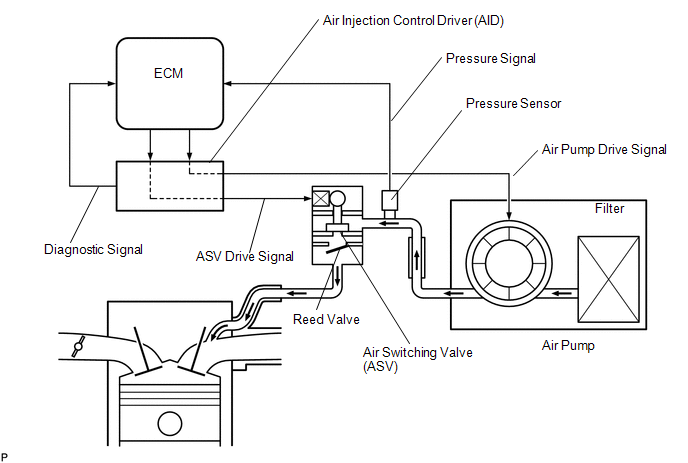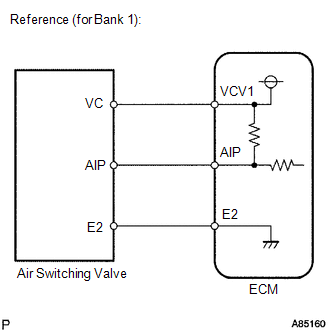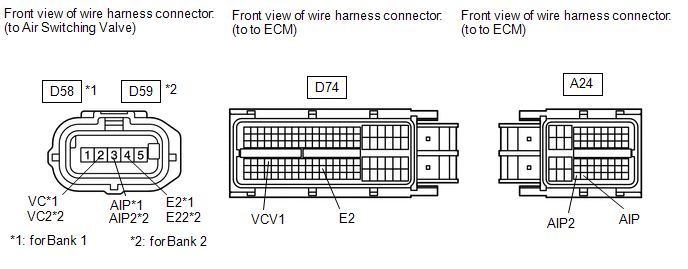DESCRIPTION The Secondary
Air Injection (AIR) system consists of an air pump, the Air Switching
Valve (ASV), a pressure sensor, the Air Injection Control Driver (AID)
and the ECM. For a short time after a cold engine start, the AIR system
pumps secondary air to the exhaust port of the cylinder head to purify
the exhaust emissions. The secondary air is supplied by the air pump and
is pumped to the exhaust port through the ASV. The
AID drives the ASV and the air pump according to command signals
transmitted by the ECM. The pressure sensor detects the pressure in the
secondary air passage when the AIR system is ON and OFF, and transmits a
pressure signal to the ECM. The AID is not only
equipped to drive the pump and valve, but also has a diagnosis function
to detect malfunctions in the AIR system circuit. HINT: As a large current is required to drive the air pump and ASV, an AID is installed to this system.
 |
DTC No. | DTC Detection Condition |
Trouble Area | | P2431
P2436 | Pressure sensor indicates less than 45.6 kPa (342 mmHg), or more than 135 kPa (1013 mmHg) (2 trip detection logic) |
- Pressure sensor (Air switching valve assembly)
- Open or short in pressure sensor circuit
- ECM
| | P2432
P2437 | While engine running, voltage output of pressure sensor remains below 0.5 V (1 trip detection logic) |
- Pressure sensor (Air switching valve assembly)
- Open or short in pressure sensor circuit
- ECM
| | P2433
P2438 | While engine running, voltage output of pressure sensor remains above 4.5 V (1 trip detection logic) |
- Pressure sensor (Air switching valve assembly)
- Open or short in pressure sensor circuit
- ECM
| MONITOR DESCRIPTION
 The
ECM monitors the pressure in the secondary air passage using the
pressure sensor located on the air switching valve in the secondary air
injection system. If there is a defect in the
sensor or the sensor circuit, the voltage level deviates from the normal
operating range, the ECM interprets this deviation as a malfunction in
the pressure sensor or circuit and stores a DTC. MONITOR STRATEGY |
Related DTCs | P2431: Air flow/Pressure sensor circuit rationality
P2432: Air flow/Pressure sensor circuit range check (Low voltage) P2433: Air flow/Pressure sensor circuit range check (High voltage)
P2436: Air flow/Pressure sensor circuit rationality P2437: Air flow/Pressure sensor circuit range check (Low voltage)
P2438: Air flow/Pressure sensor circuit range check (High voltage) | |
Required Sensors/Components (Main) | Pressure sensor | |
Required Sensors/Components (Related) |
- | | Frequency of Operation |
Continuous | | Duration |
P2432, P2433, P2437, P2438: 0.5 seconds P2431, P2436: 5 seconds | |
MIL Operation | P2432, P2433, P2437, P2438: Immediate
P2431, P2436: 2 driving cycles | |
Sequence of Operation | None | TYPICAL ENABLING CONDITIONS P2431 and P2436 |
Monitor runs whenever following DTCs not present |
P2432, P2433, P2437, P2438 (AIR pressure sensor - Low/High) | |
Starter | OFF | |
Battery voltage | 8 V or more | |
Ignition switch | ON | P2432, P2433, P2437 and P2438 |
Monitor runs whenever following DTCs not present |
None | | Starter |
OFF | | Battery voltage |
8 V or more | | Ignition switch |
ON | TYPICAL MALFUNCTION THRESHOLDS P2431 and P2436 |
Air pressure | Less than 45.63 kPa (342 mmHg), or more than 135 kPa (1013 mmHg) | P2432 and P2437 |
Air pressure sensor voltage | Less than 0.5 V | P2433 and P2438 |
Air pressure sensor voltage | More than 4.5 V | COMPONENT OPERATING RANGE |
Air pressure sensor voltage | Between 0.5 V and 4.5 V | CONFIRMATION DRIVING PATTERN
NOTICE:
- This Secondary Air Injection Check only allows technicians to operate the AIR system for a maximum of 5 seconds.
Furthermore, the check can only be performed up to 4
times per trip. If the test is repeated, intervals of at least 30
seconds are required between checks.
While AIR system operation using the Techstream is prohibited, the Techstream display indicates the prohibition (WAIT or ERROR).
If ERROR is displayed on the Techstream during the test, stop the engine for 10 minutes, and then try again.
- Performing the Secondary Air Injection Check repeatedly may cause damage
to the AIR system. If necessary, leave an interval of several minutes
between System Check operations to prevent the system from overheating.
- When performing the Secondary Air Injection Check operation after the
battery cable has been reconnected, wait for 7 minutes with the ignition
switch turned to ON or the engine running.
- Turn the ignition switch off when the Secondary Air Injection Check operation finishes.
- Start the engine and warm it up.
- Turn the ignition switch off.
- Connect the Techstream to the DLC3.
- Turn the ignition switch to ON.
- Turn the Techstream on.
- Clear DTCs (if set) (See page
 ). ).
- Turn the ignition switch off and wait for at least 30 seconds.
- Turn the ignition switch to ON and turn the Techstream on.
- Enter the following menus: Powertrain / Engine and ECT / Utility / Secondary Air Injection Check / Automatic Mode.
- Start the engine after the Techstream initialization is finished.
- Perform the System Check operation by pressing ENTER (Next).
- Perform the following to confirm the AIR system pending codes: Press ENTER (Exit).
- Check for pending DTCs.
OK:
No pending DTC is output.
- After the "Secondary air injection check" is completed, check for All
Readiness by entering the following menus: Powertrain / Engine and ECT /
Utility / All Readiness.
- Input the DTC: P2431, P2432, P2433, P2436, P2437 or P2438.
- Check the DTC judgment result.
|
Tester Display |
Description |
|
NORMAL |
- DTC judgment completed
- System normal
|
|
ABNORMAL |
- DTC judgment completed
- System abnormal
|
|
INCOMPLETE |
- DTC judgment not completed
- Perform driving pattern after confirming DTC enabling conditions
|
|
N/A |
- Unable to perform DTC judgment
- Number of DTCs which do not fulfill DTC preconditions has reached ECU memory limit
|
HINT:
- If the judgment result shows NORMAL, the system is normal.
- If the judgment result shows ABNORMAL, the system has a malfunction.
- If the test result is INCOMPLETE or N/A and no pending DTC is output,
perform a universal trip and check for permanent DTCs (See page
 ). ).
HINT:
- If no permanent DTC is output, the system is normal.
- If a permanent DTC is output, the system is malfunctioning.
- Turn the ignition switch off.
WIRING DIAGRAM Refer to DTC P0412 (See page
  ). ). CAUTION / NOTICE / HINT
HINT:
PROCEDURE |
1. | CHECK HARNESS AND CONNECTOR (AIR SWITCHING VALVE - ECM) |
 (a) Disconnect the air switching valve connector.
(b) Disconnect the ECM connectors. (c) Measure the resistance according to the value(s) in the table below.
Standard Resistance: |
Tester Connection | Condition |
Specified Condition | |
D58-3 (AIP) - A24-54 (AIP) |
Always | Below 1 Ω | |
D58-2 (VC) - D74-67 (VCV1) |
Always | Below 1 Ω | |
D58-4 (E2) - D74-98 (E2) |
Always | Below 1 Ω | |
D59-3 (AIP2) - A24-53 (AIP2) |
Always | Below 1 Ω | |
D59-2 (VC2) - D74-67 (VCV1) |
Always | Below 1 Ω | |
D59-4 (E22) - D74-98 (E2) |
Always | Below 1 Ω | |
D58-3 (AIP) or A24-54 (AIP) - Body ground |
Always | 10 kΩ or higher | |
D58-2 (VC) or D74-67 (VCV1) - Body ground |
Always | 10 kΩ or higher | |
D59-3 (AIP2) or A24-53 (AIP2) - Body ground |
Always | 10 kΩ or higher | |
D59-2 (VC2) or D74-67 (VCV1) - Body ground |
Always | 10 kΩ or higher |
| NG |
 | REPAIR OR REPLACE HARNESS OR CONNECTOR |
|
OK |
 | |
| 2. |
INSPECT AIR SWITCHING VALVE ASSEMBLY (PRESSURE SENSOR) |
(a) Connect the Techstream to the DLC3. (b) Turn the ignition switch to ON.
(c) Turn the Techstream on. (d)
Enter the following menus: Powertrain / Engine and ECT / Data List /
Air pump pressure (Absolute) and Air Pump2 Pressure (Absolute). (e) Check the pressure displayed on the Techstream.
Standard pressure: 45 to 135 kPa HINT: The Techstream displays the air pump pressure as absolute pressure. Result |
Result | Proceed to | |
OK | A | |
NG (for Bank 1) | B | |
NG (for Bank 2) | C |
| A |
 | REPLACE ECM |
| B |
 | REPLACE AIR SWITCHING VALVE ASSEMBLY (FOR BANK 1) |
| C |
 | REPLACE AIR SWITCHING VALVE ASSEMBLY (FOR BANK 2) | |


